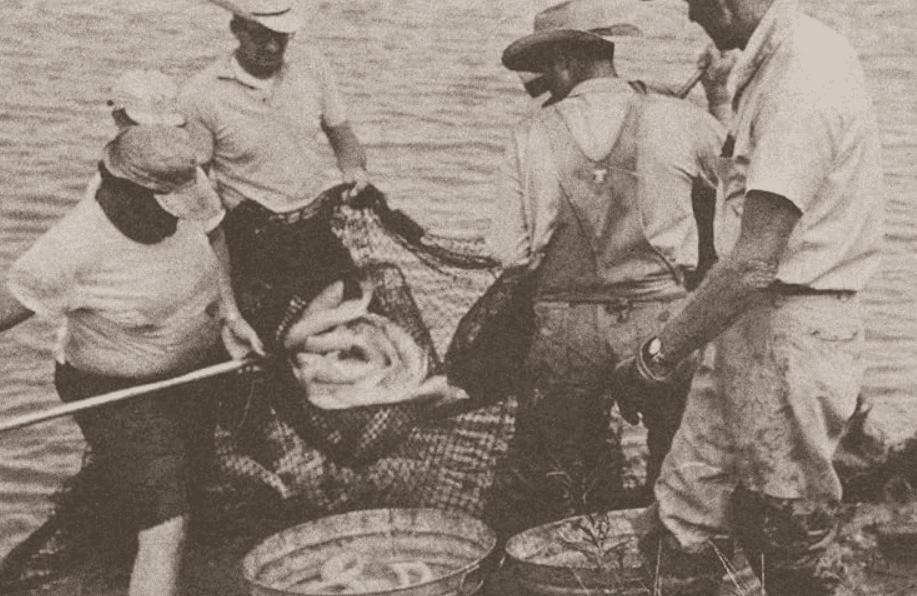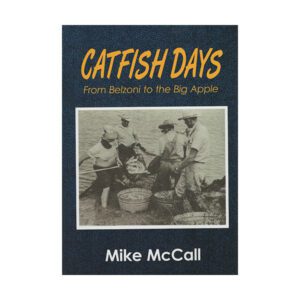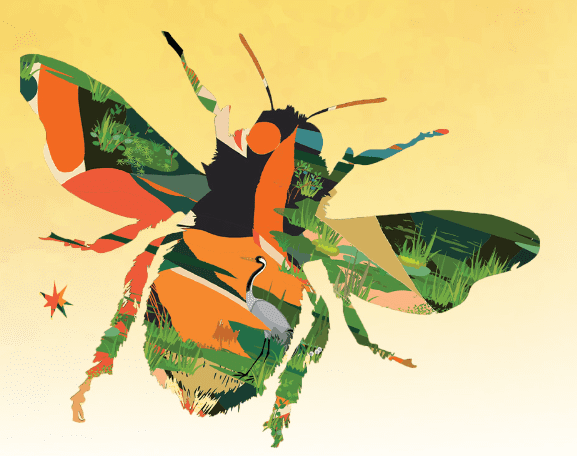
(Photo from the cover of Catfish Days by Mike McCall)
McCall’s work of creative nonfiction names the names and reports the thousands of acres farmed, millions of dollars in pounds sold, and fortunes lost in the catfish industry.
What ugly bottom-dwelling and watery quasi-Gold Rush creature did Faulkner, Hemingway, Twain, and Mike McCall all write about?
What sleek, whiskered, razor sharp-finned thing drew attention from BB King, Willie Nelson, Willard Scott, Oprah Winfrey, and Craig Claiborne?
What living thing so described could have stimulated both modest fortunes and bankruptcies; for its value to be told in hundreds of millions of dollars and billions of tons weight-wise?
“Catfish,” declared Mike McCall in his introduction to the definitive history of the catfish farming industry, brilliantly revealed in his 2016 book, Catfish Days: From Belzoni to the Big Apple.

Likely, most people sniff the scent of fried catfish along with hush puppies and thin-sliced potatoes accompanied by coleslaw. But over the six decades the catfish industry has existed in Mississippi and neighboring states, far more exotic concoctions have been developed.
McCall wrote about throngs of folks who enjoy catfish in settings from the back end of a pickup to the finest restaurants in Chicago, New Orleans, and New York. He additionally assures readers that Delta and other eateries also dish up delicious meals of farm-raised catfish.
The journalist-turned-editor writes authoritatively – the heralded storyteller is as an expert. Native to Jackson with a University of Southern Mississippi education, McCall reported for the Clarion-Ledger, Memphis Commercial Appeal, and Biloxi Sun-Herald. Along the way, he became interested in business journalism, choosing to specialize in that branch that tracks, records, analyzes, and interprets changes in business, economic, and financial activity. He co-founded the Mississippi Business Journal, was business editor of the Clarion-Ledger, and for more than thirty years has edited The Catfish Journal.
Catfish Farmers of America issues the official trade publication, now distributed four times a year, as a membership benefit. Established in mid-1986, the Journal covers America’s largest aquaculture industry—catfish farming.
Another industry voice McCall promotes, The Catfish Institute (TCI) was organized in 1986 to support local farmers and promote US farm-raised catfish as a healthy, sustainable, and delicious menu option. TCI showcases The Catfish Trail on its website, featuring popular catfish restaurants, and “Catfish is Life” presents videos that feature current farmers as well as recipes for everything catfish.
In developing his Catfish Days book, McCall recalled his own news and feature stories along with interviews, shared documents and photographs, an extensive library of fish farming publications, and coverage of the industry’s early years in The Catfish Farmer.
“Catfish is a plenty good enough fish for anyone,” Mark Twain wrote and McCall quoted.
Setting the stage from historical accounts that trace the catfish species from the days of Egyptian ruler Narmer, who lived about 3100 BC, the author cites celebrity attention and political play-by-plays fixed on the saga of “a slippery hero who swam out of the darkness and into the light.”
One storyline reveals the origin of one of the South’s best-known menu items from a small café and bar opened July 4, 1934, in a tin-roofed building on US Highway 51 just off Lake Maurepas in Louisiana. In that kitchen, Josephine Arizona Bates—Josie, as she preferred—grew up in Tangipahoa Parish, moved to Manchac, waited tables in Hammond, moved to Baton Rouge, before landing at the luxurious Peabody Hotel in Memphis. Josie married “a tall, handsome hotel guest twenty years her senior,” Louis Middendorf, the son of German immigrants and a World War I veteran. After the stock market collapse, they moved to Manchac, lived with Josie’s mother, and invested in that eatery, in a location with a rich history of French, Spanish, and American colonial efforts.
McCall wrote that they “furnished the building with a few tables and chairs and kitchen essentials. Josie cooked while Louis handled the front of the house. Her ‘thin fried catfish’ was especially popular.”
That story continues, woven into McCall’s revelations of raising catfish for money, tracing the pioneers who established farms along with those who processed, marketed, and sold the fish.
“Dozens of catfish producers fought the challenges of raising fish—growing a crop to maturity only to lose it to a lack of oxygen or disease. But they carried on.”
The risky, grueling business drew hundreds of farmers, investors both small and large as Hormel and ConAgra, as well as restaurateurs including Charlie Trotter, Wolfgang Puck, and Emeril Lagasse. Bankers, entrepreneurs who developed special catfish food and built processing conglomerates, scientists, and curious news organizations got involved.
“The work was hard and hours were long,” and harvesters “struggled with oversized ponds, sometimes exceeding forty acres… the pond was drained and men sloshed down the muddy bank where the fish were corralled, loaded in wash tubs and carried up the pond bank to a truck where the fish were spread and covered with ice, then another layer of fish, and so on. It was back-breaking labor in sometimes 100-degree heat or sub freezing cold.”
McCall’s work of creative nonfiction names the names and reports the thousands of acres farmed, millions of dollars in pounds sold, and fortunes lost. “Such was the life of a catfish newspaper editor, trying to report the news amid swirling power struggles, an intense rumor mill, and old fashion personality conflicts.”
The book reveals the glory days, changes due to research and technology, plus new generations of employers, employees, and investors, and the impressive growth and decline in every aspect of the industry.
“As the catfish industry infrastructure expanded, its economic impact was felt throughout the region… In 1996, the catfish industry was on a torrid pace. Production acreage had ballooned to nearly 180,000 acres of water, spread over a dozen states, although the big four—Mississippi, Arkansas, Alabama, and Louisiana—still claimed a large majority of production. Processing approached 600 million pounds of live catfish annually. Catfish production covered 180,000 acres, continuing the expansion. Three years later, the industry recorded its most robust numbers—660 million pounds of catfish processed from 192,000 acres of production.”
Now, McCall reports, the poundage per year is about 340 million, with about one-third the acreage compared to twenty-five years ago. And the safety of farm-raised compared to wild caught? The fish live in a “very controlled environment. The only chemicals used are the same as are in a public water system. Quality is a Very Big Thing—it’s all about the water and the air. USDA food inspection service now inspects ponds and fish with much more rigid regulations than the FDA.
Another important consideration is country of origin labeling (COOL), especially focused on alerting consumers to ask about where the fish they are buying originated.
“Retail markets and restaurants in some states have to identify if fish is imported. Ask the server at the restaurant and read the labels at the grocery.”
McCall admits that as an author, he “might be a one-time deal.” To produce four Journals a year, he works part-time because he enjoys the work and the industry.
“I know so many people in the industry, and we are like a big family. Yes, sometimes family members might disagree, but they keep moving forward.”
Now returned to the Jackson area from his previous residence in Point Clear, Alabama, McCall’s book can be obtained via email or from Amazon.











